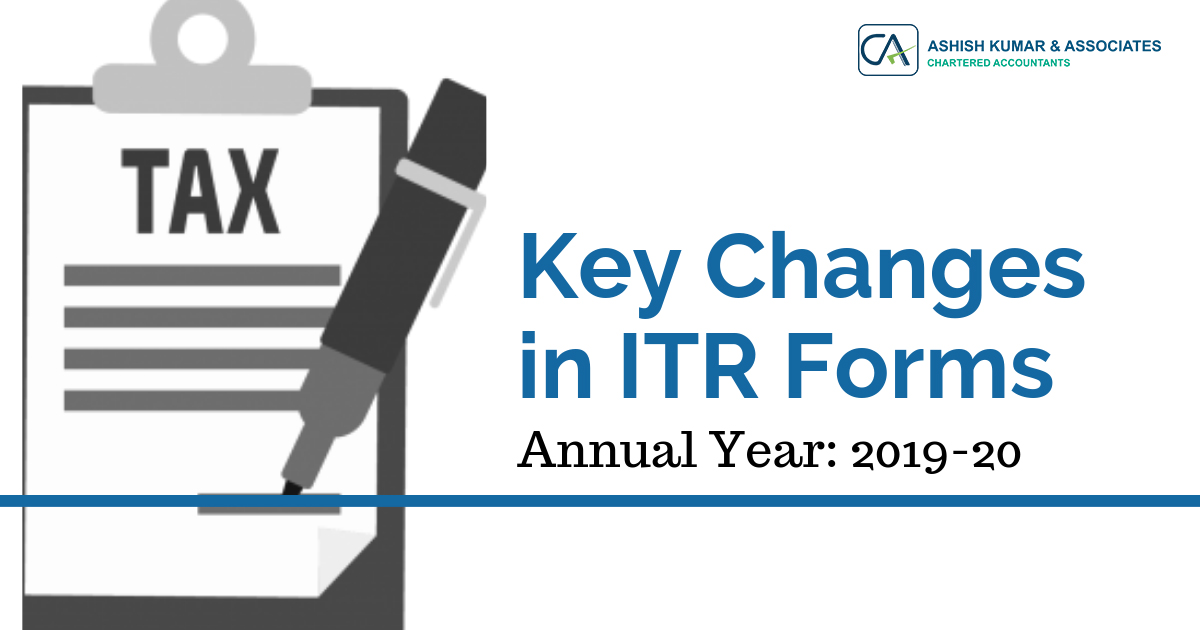The ITR Forms of Income-Tax Return Forms for the assessment year 2019-20 has been introduced by the CBDT with numerous changes. In this post, we will tell you the 5 major changes made in ITR forms for individuals.
1. Investment in Unlisted Companies (ITR 2,3,5)
When a company issues shares at a lesser price than its FMV and the difference between issued price and FMV is more than INR 50,000 then this difference is charged to tax within the hands of shareholders under the head income from various sources.
To keep a close check on such issue of shares by a closely held company and an investment made by the shareholders, a novel table has been incorporated in the new ITR forms. This table seeks the following details in respect to unlisted equity shares held by an assessee at any time during the previous year.
- Company’s Name
- PAN details of the Company
- Cost and no of acquired shares held at the beginning of the year
- Face value, numbers, date of purchase, and the issue price of shares brought during the year
- Number and sale consideration of shares transferred during a specific year
- Number and cost of acquisition of shares owned at the end of the previous year
2. Identification of Shell Companies and Ghost Directors (ITR 1,2,3,4)
Over the years, the Indian government has taken numerous initiatives to curb the shell companies and black money. Among them, one such initiative is to identify the ghost directors who even are not aware that they are directors in companies.
According to this rule, it is compulsory for every director in a company to file KYC form DIR 3. Failing to do so will result in the deactivation of his DIN or Director Identification Number.
Now, a few changes have been made in ITR forms by the government to identify the ghost directors and shell companies. A director in the company must not be able to use ITR-4 and ITR-1 for return of income filing and it is mandatory for him to use ITR 2 or ITR 3, whatever the case may be. Moreover, the individual positioned as the director in a company at any time during the previous year must provide the following details:
- PAN
- Name of Company
- DIN
- Listed or Unlisted Shares of the Company
3. Buyer’s Information Now Needed During Transfer of Immovable Property (ITR 2,3,5,6)
If a capital gain has been reported by an assessee from the transfer of immovable property, then it is compulsory for him to provide the following details about the buyer:
- Buyer’s Name
- PAN details of the buyer
- Amount
- Percentage Share
- Property Address
- Pin Code
The assessee must furnish the details of the buyer in ITR form if tax has been deducted under section 194-IA or if the PAN is quoted by the buyer within the registration documents.
Otherwise, PAN is a mandatory document to sell or buy an immovable property if the stamp duty value or the sale consideration is more than INR 10 Lakhs.
4. ITR 1 and ITR 4 Need Nature of Residuary Income (ITR 1 and ITR 4)
Till the assessment year 2018-19, the taxpayers were needed to disclose the average amount of income taxable under other sources.
But from the assessment year 2019-20, it is compulsory for an assessee to specify the nature of income taxable under the head income from different sources and the deductions claimed in context to family pension in accordance with section 57. These extra disclosures are needed by the department in order to check and confirm that ineligible individuals are not using ITR 1 and ITR 4 forms for filing return.
5. Reporting the Salary Income on Gross Basis (ITR 1,2,3,4)
Under the new ITR forms, the mechanism for reporting the gross salary income has changed. Till the assessment year 2018-19, the individuals were expected to report salary amount excluding all exempt and non-exempt allowances, profit and perquisites in lieu of salary. Such items were reported separately in the same schedule and have no impact on the estimation of net salary income.
However, as per the new ITR forms, this mechanism has been changed, which is now in sync with the columns mentioned in form 16 of TDS certificate issued by the employer. From the assessment year 2019-20, the individual has to provide his gross salary as well as the sum of exempt allowances, profit, and perquisites in lieu of the salary. The same must be deducted or added in order to achieve the taxable figure of the salary income. Moreover, the new ITR form needs separate reporting of the deductions made under section 16, such as:
- Entertainment allowance
- Professional tax
- Standard Deduction





